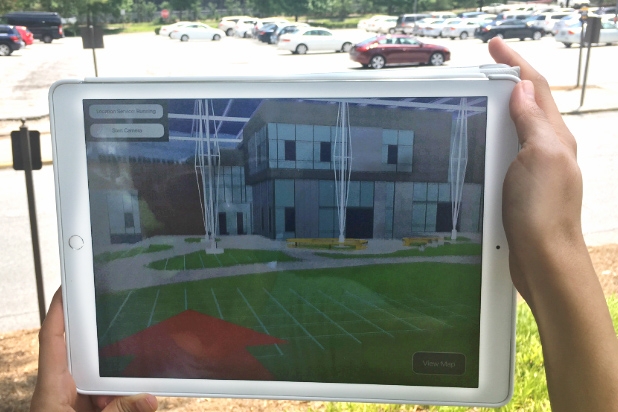
 Using an iPad and an augmented reality model, students and other future users of Georgia Tech's Living Building will be able to tour the facility long before it opens, offering input on some of the design decisions. The project is the work of Frederick Law Olmsted Professor John E. Taylor, architect Alissa Kingsley, and a team of Georgia Tech researchers and developers. (Photo Courtesy: Kendeda Fund Living Building Chronicle) |
Georgia Tech students are going to be able to tour the campus’ new Living Building long before it ever opens to the public, thanks to the efforts of a group of Tech researchers and developers, including Frederick Law Olmsted Professor John E. Taylor, and architect Alissa Kingsley.
Together, they’re developing an augmented reality model of the building so the students and others who will eventually use the facility can offer input before construction. Most of the major design work is finished, but their ideas could help shape some of the critical interior and exterior details.
The project — which also includes researchers Neda Mohammadi and Abigail Francisco and developers Sean Flanagan and Yunhe Song — is one of six efforts to involve students in the Living Building project and broaden its impact. Each recently received a grant of $10,000.
More about Taylor’s project from the Kendeda Fund’s Living Building Chronicle:
Occupants typically don’t have much say about a building’s design until after it’s built. Then, it’s too late. The “Living Building Community Crowdsourcing” pilot project aims to give future occupants, along with other stakeholders, a chance at making meaningful suggestions beforehand.
Civil Engineering Professor John E. Taylor’s is working with Alissa Kingsley, one of the building’s architects, to develop an interactive, augmented-reality model of the building. The pilot project will allow potential occupants and visitors to “spatially visualize” the building by taking a 3-D tour via an iPad.
This technology has the potential to allow visitors to view and experience the building from several perspectives, gather direct feedback from users that captures their insights on arbitrary elements, and deliver diverse community ideas to inform building design decisions in a more equitable manner.
Part of the project will involve student canvasser, at the building itself, gathering feedback by engaging passersby to interact with the augmented reality program. While many design decisions already have been made, the feedback could influence interior and exterior details. The feedback will be structured to address the Living Building Challenge’s seven petals.
Signage will be posted at the deployment site and across campus to promote engagement from all students, staff, and visitors. After the deployment, collected data will be analyzed and summarized to facilitate its incorporation into the building design.
Taylor and Kingsley, who are members of Georgia Tech’s Equity Petal Working Group, view crowdsourcing as an opportunity to gather information from a diverse set of potential occupants “while reducing the risk of costly fixes in the future.” They argue in their project description that grassroots feedback “is a departure from a top-down approach, in which building designers may be disconnected from a project’s end users.”
Taylor is leveraging a virtual reality platform developed at the university’s Network Dynamics Lab under a National Science Foundation grant. He hopes it will lead to further development of crowdsourcing applications for the built environment. His team currently is developing an extended version of the application that models the entire campus to crowdsource feedback on each of the seven Living Building Petals on how Georgia Tech could evolve to a “Living Campus.”
Continuation of this feedback loop could be deployed during the construction and operations phases of the building to sustain connections between occupants and the building and show Georgia Tech’s commitment towards creating inclusive spaces. Findings from the data will likely be broad, and be able to be applied across other buildings on campus or inform design standards.
This fall, Taylor plans to involve an interdisciplinary civil engineering course he teaches on Smart and Sustainable Cities in testing and development of the augmented reality app.
